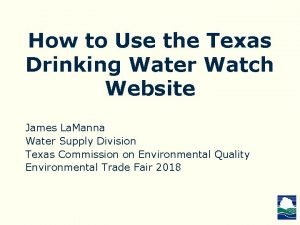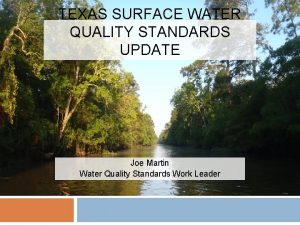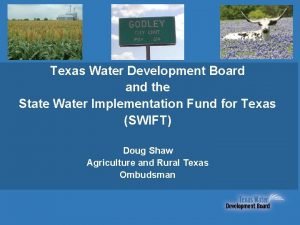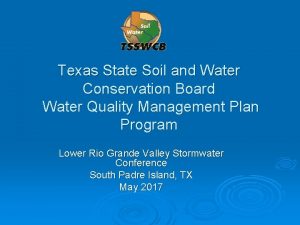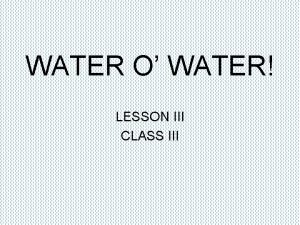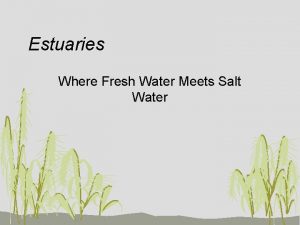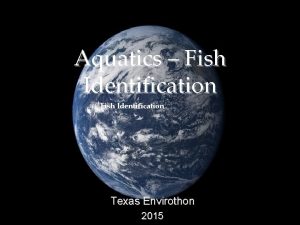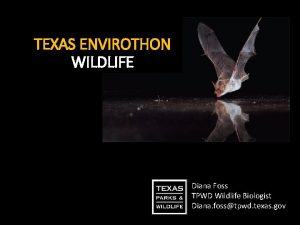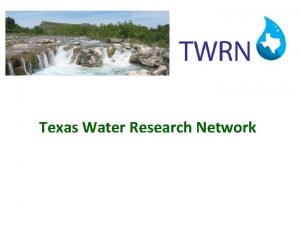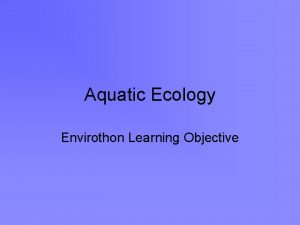Water 2016 Envirothon Andrew Sipocz Andrew Sipocztpwd texas













- Slides: 13

Water 2016 Envirothon Andrew Sipocz Andrew. Sipocz@tpwd. texas. gov (281) 456 -8266 x 229

TOPICS q. Clean Water Act • What about our waters do we care about? • How do we measure these aquatic things (parameters)? • Why are these parameters important? q. Wetland Restoration at Sheldon Lake State Park • Why? • How (funding and operations)? q. Aquatic Invasives • Fish, plants and invertebrates • Ecology of aquatic invasives

Clean Water Act • 1972 (Richard Nixon) • Protects the Physical, Chemical and Biological Integrity of the Nation’s Waters • Must measure throughout the day and seasons and compare to REFERENCE WATERS and/or make comparisons at the same site through time and/or before and after alterations (time series)

Physical Integrity of Our Waters q. Temperature • Measured with a thermometer, usually part of an instrument package • Controls the rate of metabolism (respiration rate) of aquatic organisms and the amount of dissolved oxygen in the water as well as some elements Ø Cooling water effluent (example: Sabine Lake LNG effluent) Ø Dams (example: loss of salmonids in western rivers) Ø Loss of bankside vegetation (example: loss of salmonids from grazing) Ø Water diversions and tailing water effluent (return flows from irrigation) q. Turbidity/Clarity q. Flow

Physical Integrity of Our Waters q. Temperature q. Turbidity/Clarity • Measured with a light meter or Secchi disc in the field, also determined by dry weight of filtered (total) and then ashed (mineral) water samples to separate organic and inorganic fractions. Mineral and organic sediment including phytoplankton as well as tannins all affect this measurement. Often highly variable in nature making this hard to pin down. • Strongly affects phytoplankton photosynthesis, filter feeders, sight predators, egg respiration Ø Agricultural runoff (most widespread water pollutant in the U. S. by far) Ø Storm water runoff (largely unregulated) Ø Long term these pollutants can completely change aquatic systems by changing bottom sediment type Ø Strongly affect growth of submerged aquatic vegetation such as seagrasses, also negatively affect filter feeders such as corals and oysters Ø Occasionally decreases in natural turbidity from dams also have adverse effects (Lake Powell/Nile) q. Flow

Physical Integrity of Our Waters q. Temperature q. Turbidity/Clarity q. Flow • Measured with flow meters (speed X cross-section) • Changes to both timing of flows and total volume can degrade aquatic systems Ø Irrigation diversions (Sacramento Delta, Aral Sea) Ø Hydroelectric power (Esp. SE Rivers) Ø Locks and Dams (Mississippi River) Ø Reservoirs cause loss of flood flows (Colorado River - loss of wetland breeding fish, suspended eggs) • Physical blocking of flow Ø Dams (blocking of aquatic migrations, sediment flow)

Chemical Integrity of Our Waters q. Nutrients (water samples and lab analysis) • Especially Nitrogen and Phosphorous Ø Ø Eutrophication (wide swings in D. O. , loss of less tolerant species) Difficult to measure as they cycle quickly through the system Fertilizer, sewage plants, manure runoff, yard wastes Nitrogen can be removed by wetlands but especially in lakes, Phosphorous is forever qp. H (multi-meter) • Indicates photosynthesis rate • Also indicates acid pollution (sulfates, carbon dioxide) Ø Especially important to shell-building animals q. Dissolved Oxygen (multi-meter) q. Dissolved Minerals (multi-meter, refractometer) • Especially salts (mine runoff, irrigation tail water) q. Dissolved Organic Matter (water samples and lab analysis) q. Pesticides, biocides, estrogens and hormone imatators (small-mouth bass)

Biological Integrity of Our Waters q. Habitat (remote sensing - aerial photos and satellite data as well as direct measurements, status and trend data) • Loss of bank side vegetation • Loss of wetlands • Changes to shorelines of rivers and lakes for navigation, flood control, recreation, development • Gross changes to stream channel, lake and bay morphology from channelization, flood scour, navigation channels Ø All of these lead to losses in species and abundance Ø Often irreversible

John S. Jacob Director. Texas Coastal Watershed Program Kirana Pandian Ricardo Lopez Heather Biggs Former Extension Associates Texas Coastal Watershed Program The Texas A&M University System Status and Trends Report on Galveston Bay Watershed wetland losses

Invasive Aquatic Species Biological Pollution q. Plants • Long list • Texas Invasives. org Ø Water Hyacinth Ø Giant Salvinia Ø Chinese Tallow Ø Peruvian Water Primrose Ø Torpedo Grass • Can a native plant be invasive? q. Fish q. Invertebrates

Invasive Aquatic Species Biological Pollution q. Plants q. Fish • Saltwater Ø Lionfish – reef fish Ø Giant Tiger Prawn • Freshwater Ø Armored Catfish Ø Grass Carp Ø Tilapia Ø Pacu Ø Snakehead q. Invertebrates Eric Engbretson David Knott

Invasive Aquatic Species Biological Pollution q. Plants q. Fish q. Invertebrates • Freshwater Ø Zebra Mussels Ø Asian Clam Ø Spiny Water Flea • Saltwater Ø Brown Crab

Why are They Invasive? • Evolution works between interacting organisms on a long term basis • Interactions are limited by geography • Humans erase geography
 Water and water and water water
Water and water and water water Dww tceq
Dww tceq Texas drinking water watch website
Texas drinking water watch website Texas surface water quality standards
Texas surface water quality standards Texas state water board
Texas state water board Texas state soil and water conservation board
Texas state soil and water conservation board Drinking fountain
Drinking fountain Fresh water allowance
Fresh water allowance Water o water
Water o water 5 divided by 1/4
5 divided by 1/4 A paved blacktop parking lot was built
A paved blacktop parking lot was built Water exchanger
Water exchanger Fresh water meets salt water
Fresh water meets salt water Warm water rises in a lake. cold water descends.
Warm water rises in a lake. cold water descends.


